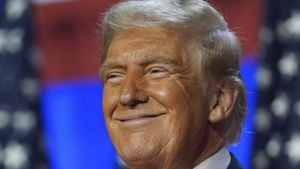China's economic outlook has become increasingly complicated as the nation grapples with sluggish growth, social unrest, and shifting geopolitical dynamics. Analysts are painting a picture of both potential and peril within the world's second-largest economy, emphasizing how measures aimed at revival are being tested against mounting societal pressures and international trading challenges.
After nearly three years of strict COVID-19 restrictions, which were finally lifted at the end of 2022, China is currently struggling to boost consumer confidence and spending. Despite efforts from the government, including stimulus measures aimed at revitalizing economic activity, the recovery has been tepid. According to recent reports, major Chinese companies like JD.com and Alibaba have reported modest gains, yet these figures highlight cautious consumer behavior rather than a full economic comeback.
JD.com announced its latest quarterly revenue surged 5.1% to approximately 260.4 billion yuan ($36 billion), just beating estimates. The increase signals some recovery, particularly within the electronics sectors, yet the overall sentiment remains cautious as analysts warn it may take time for government stimulus to create tangible benefits. Similarly, Alibaba's upcoming earnings report is anticipated to provide insight on how consumer spending is slowly shifting gears but is heavily influenced by external economic pressures.
This cautious economic environment has inadvertently led to rising social tensions, including incidents of violent crime. The recent surge of violent acts, including the deadliest mass killing seen in China for over ten years, has shocked many citizens and triggered conversations about the broader societal impacts of economic stress. Analysts noted these incidents are often born from deep-seated frustrations linked to economic malaise and uncertainty about job security.
Indeed, social media platforms, heavily monitored by the state, have become battlegrounds for public sentiment concerning the economy. Terms like "garbage time of history"—an analogy drawn from sports to describe periods of low-quality performance when outcomes seem predetermined—are cropping up among citizens, reflecting their fears of stagnation.
China's economic issues are compounded by the realities of their global trade relationships, especially with the United States. With the return of Donald Trump and his predilection for confrontational trade policies, there's grave concern among Chinese manufacturers about new tariffs and trade restrictions. Alibaba, having sought to diversify and expand globally, now faces obstacles brought on by renewed geopolitical tensions.
The Morgan Stanley report speaks to these shifting dynamics, predicting India, Indonesia, the Philippines, and Malaysia's economies will become the primary drivers of growth within Asia, overshadowing China's once-dominant role. This shift is attributed to demographic changes, policy adjustments, and the region's need for economic diversification.
While the report projects substantial growth for the aforementioned Southeast Asian nations, the forecast for China highlights the potential for diminishing influence as its age demographic shifts and its political structures remain static. Economically inclusive institutions are seen as key to sustained growth; China’s framework, rooted still more on extraction rather than inclusion, raises concerns about its growth sustainability.
Despite the unsettling trends, some optimistic analysts argue the structural changes led by the Chinese government, which include policies geared toward financial market transformation and support for key sectors like technology, could re-stoke growth. The call for more inclusivity—both economically and politically—is recogized by some as integral to avoiding stagnation.
Moving forward, as the world watches, the question remains: Can China adapt to new economic realities, and can its reforms steer it back to the growth track it has long enjoyed? Or are we witnessing the beginning of the end of China as the growth engine of Asia?



